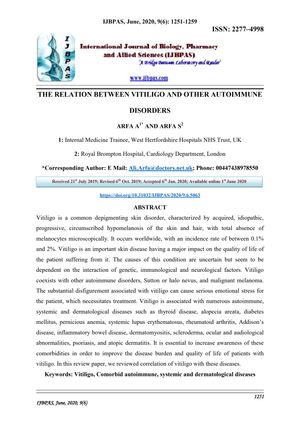The Relation Between Vitiligo and Other Autoimmune Disorders
May 2020
in “
International journal of biology, pharmacy and allied sciences
”

TLDR Vitiligo is often found with other autoimmune diseases, which is important to know to help patients.
The document reviewed the relationship between vitiligo, a common skin disorder characterized by loss of pigmentation, and various autoimmune and systemic diseases. Vitiligo, affecting 0.1% to 2% of the global population, is thought to be caused by a combination of genetic, immunological, and neurological factors. It often coexists with other autoimmune disorders such as thyroid disease, alopecia areata, diabetes mellitus, pernicious anemia, systemic lupus erythematosus, rheumatoid arthritis, Addison's disease, inflammatory bowel disease, dermatomyositis, scleroderma, as well as with dermatological conditions like psoriasis and atopic dermatitis, and also with ocular and audiological abnormalities. The review emphasized the importance of recognizing these comorbidities to improve the quality of life for patients with vitiligo.





